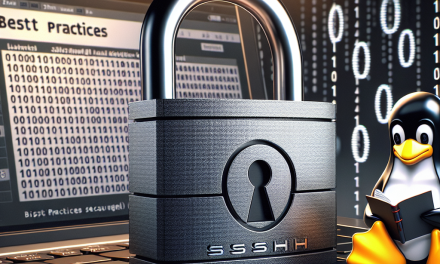Network File System version 4 (NFSv4) has emerged as a robust protocol widely used for sharing files across networks in Linux environments. While the convenience of NFS is significant, a secure implementation is crucial to safeguarding sensitive data from unauthorized access and vulnerabilities. This article explores the best practices for enhancing the security of NFSv4 on Linux servers.
Understanding NFSv4
NFSv4 is a major revision of the NFS protocol that presents several enhancements over its predecessors. These improvements include better performance, stateful operations, and built-in security mechanisms like support for Kerberos authentication and strong access control list (ACL) capabilities. By leveraging these features effectively, you can significantly bolster the security posture of your network storage.
1. Secure Configuration
a. Restricting Exports
Control access by configuring the /etc/exports file properly. Define specific hostnames or IP addresses that are permitted to mount the NFS shares. This minimizes exposure to unauthorized entities.
Example:
bash
/home/shared 192.168.1.0/24(rw,sync,no_subtree_check)
b. Using Kerberos for Authentication
Implement Kerberos authentication for NFSv4. This adds a strong layer of security through encrypted communication. To enable this, you will need to install and configure the necessary Kerberos packages on both the server and the clients.
Steps to enable Kerberos:
- Install the required packages (e.g.,
krb5-user,krb5-kdc, andnfs-kernel-server). - Set up the Kerberos realm and create service principals for your NFS server.
bash
kadmin.local: addprinc -randkey nfs/server.example.com
c. Configure Firewall Rules
Firewall rules should be strictly configured to allow only necessary traffic. NFS typically uses TCP and UDP ports 2049, but other services associated with it may require additional ports.
bash
sudo ufw allow from 192.168.1.0/24 to any port nfs
2. Enabling Secure Options
a. Use ‘sec=sys’ vs. ‘sec=krb5’
When exporting NFS shares, ensure you use Kerberos for authentication rather than the less secure ‘sys’ option. Update your /etc/exports file accordingly.
bash
/home/shared *(rw,sec=krb5,sync,no_subtree_check)
b. Turn Off Unused Services
Disable any unnecessary NFS-related services. For example, if you don’t need the NFSv3 or NFSv2 services, ensure to disable or remove them to reduce the attack surface.
bash
sudo systemctl disable nfs-server.service
3. Employing Strong Access Controls
a. Use NFSv4 ACLs
NFSv4 allows for more granular ACLs using nfs4_setfacl and nfs4_getfacl commands. Use these tools to define permissions that clearly outline who can read, write, or execute files.
Example:
bash
nfs4_setfacl -a A::user:rwn /home/shared
b. Limiting Mount Options
For clients mounting your NFS shares, limit the options that can be used. Avoid options that may expose your mounts, such as no_root_squash.
bash
/home/shared *(rw,sync,no_subtree_check,no_root_squash)
4. Regular Maintenance and Monitoring
a. Keep Your System Updated
Regularly update both the server and client systems and ensure that your NFS software is patched against known vulnerabilities.
bash
sudo apt update && sudo apt upgrade
b. Log Monitoring
Implement logging with tools like auditd to track access to your NFS shares. Regularly review logs to detect any unauthorized access attempts.
bash
sudo apt install auditd
Conclusion
Implementing NFSv4 with an eye towards security is essential in today’s environment where data breaches are common and devastating. By following the best practices outlined in this article — from secure configuration and enabling authentication mechanisms, to strong access controls and regular maintenance — you can create a robust and secure network storage solution that protects your vital data.
Stay tuned to WafaTech Blog for more insights into securing and optimizing your Linux server environment!





